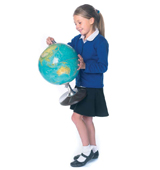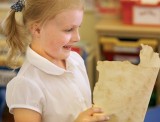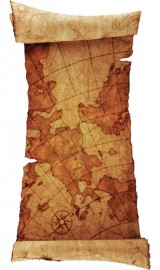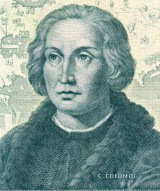Transport children back to the year that Columbus sailed the ocean blue with Jonathan Lear’s dramatic lesson ideas...
In 1492, Christopher Columbus set out on one of the best remembered voyages in history. These activities are designed to introduce his fascinating topic in a way that will both grab children’s attention and awaken their sense of enquiry.
 Recruiting Rodrigo De Triana…
Recruiting Rodrigo De Triana…
To introduce the topic, some preparation is required. The first step is to find an actor to play the role of Rodrigo de Triana, the Spanish sailor, who, under Columbus’s command, was the first to see America. You could try to find a budding actor among your school’s staff, or even do it yourself, but finding an outside actor – someone the children haven’t seen before, to add to a little extra surprise and mystery – is best. Why not contact your local secondary to see if they’ll lend you a GCSE or sixth form drama student? They’ll likely be happy to help, as it’s a great opportunity for one of their pupils to get some work experience.
Arrange a meeting with your actor to discuss their role. Initially, all they’ll have to do is deliver a torn piece of map to the class. In terms of costume, any dishevelled clothing will do for that ‘just stepped off a ship’ look! With an actor in place, the next step is to produce a map…
Using thick cartridge paper, age the map with tea bags; then, when it’s dry, tear thin strips off each edge to produce a timeworn look. Next, draw or trace an outline of the countries needed. Place Great Britain centrally, at the top edge of the paper. Continue with the rest of Europe, as far east as Turkey, and then go south as far as the middle of Africa. The countries don’t need to be drawn or identified individually; presenting the map in terms of land mass and sea is enough for now.
Finally, draw a line representing the voyage of Columbus from Italy to Spain, Spain to The Canary Islands and then across the Atlantic. The destination of the voyage, North and South America, are missing from the map – torn away and lost at sea. The line therefore extends mysteriously to the edge of the paper. Finally, in one corner of the map write ‘Pinta’ and the date ‘12 Ottobre, 1492’.
 Pore over maps and turn detective…
Pore over maps and turn detective…
During a quiet moment, have your sailor burst into the classroom, ideally a little bit wet and appearing exhausted. In their hand, they’re clutching the torn map. The sailor doesn’t need to say much – they could perhaps greet the children in Spanish, repeating the phrase “Señor, tengo un mapa!”. Having delivered the map to the teacher, the strange visitor leaves as suddenly as they arrived.
After restoring order, show the map to the children: what could it be? Get them to talk about it in pairs or small groups. Whilst they do, give out colour copies so that the children have one each.
Next, ask the children for their thoughts and ideas – who do they think the person was? Where were they from? What’s the map for? Encourage them to look closely at the map: is there anything they recognise? Take the children’s suggestions about the countries they can see. How could they discover what was on the missing section? Provide the children with atlases and allow them to continue their detective work. When they’ve discovered the missing countries, give them a sheet of paper on which to stick the torn map. Challenge them to draw in the missing half using the atlases to help.
Once the maps are completed, draw children’s attention to the incomplete line that seems to link certain countries together. Which countries are these? What do they think the line represents? Does it give them clues about the person who delivered the map? What could the word ‘Pinta’ mean? Encourage the children to speculate about the final destination of the journey.
To finish the session, give the children post-it notes so they can record questions about the visitor or the map.
 Interrogate the past in person…
Interrogate the past in person…
This hot-seating activity allows the children to have some of their questions answered by the character Rodrigo de Triana. Before the session begins, our new best-friend, the drama student, has got some homework to do! It’s important that they’re able to convey some accurate facts about the voyage made by Columbus in order to answer the children’s questions. To help with this, the BBC schools website has an interactive, child-friendly biography of Christopher Columbus which gives concise pieces of information, covering most of the questions the children will ask – http://www.bbc.co.uk/schools/famouspeople/standard/columbus
Some of the facts to include are:
• Columbus was attempting to find a new route to China
• Although Columbus was Italian, he sailed from Spain after persuading the king and queen to give him the money he needed.
• Columbus had three ships, the Niña, the Pinta and the Santa Maria.
• The sailors spent most of their time on deck and worked shifts that were measured with a half hour glass
• The sailors were terrified that they would be lost at sea and forced Columbus to agree to turn back.
• Just before turning back, Rodrigo spotted land, shouting “Tierra! Tierra!”
This information should be delivered in role by the actor. Depending on their level of confidence, it could be added to or reduced – even if Rodrigo can only offer a small amount of information, the children will be desperate to find out more themselves.
Tell the children they’re going to meet the visitor who delivered the map. Explain that Rodrigo was born in Seville, Spain, in 1469, and that he’s come to tell them about his adventure. Sit Rodrigo in front of the children. Ask the character to talk a little bit about himself, following which the children can ask the questions they generated in the previous session.
 Continuing the Columbus theme…
Continuing the Columbus theme…
• Using the information they’ve learned, children could write diary extracts as Rodrigo or other members of the ships’ crews.
• Using the BBC website, children could find out more about Columbus – where did he travel to? Which other countries did he explore? This could lead to the children filming their own travel documentaries.
• Create a living library. Could the children do the job of the actor who played Rodrigo, or play the part of the King of Spain, Columbus, a Native American? They would have to research their role carefully to ensure a professional performance! Children, staff and parents could then ‘take out’ a living book to find out more about this period in history.
5 Ways To Celebrate World Book Day
Ace-Classroom-Support
Becoming a teaching school
Ace-Heads
